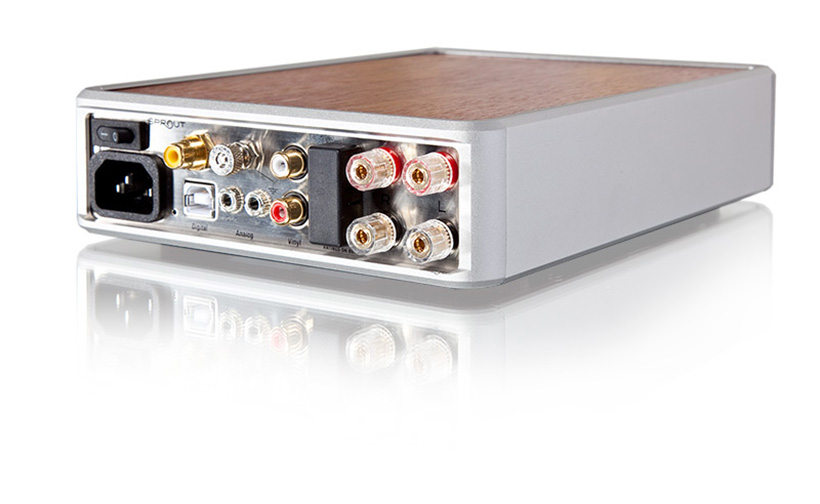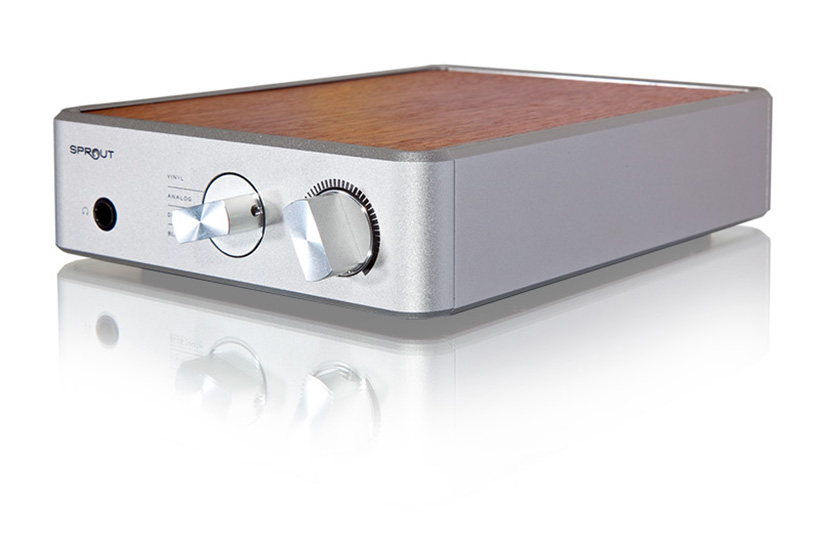Like father, like son is certainly true for Paul and Scott McGowan of PS Audio. Scott developed his own amplifier under the name of his father’s company but financed it with crowd sourcing website Kickstarter. It’s a totally different amplifier to anything PS Audio has yet made, both in looks and technology. The Sprout is designed to be a handy tool that’s affordable for many people, especially those living in the US.
Swiss army knife?
The Sprout is a small amplifier with a footprint that’s only 23cm deep including knobs and terminals. The wood print on the top panel contrasts with the natural silver of the sides and there is volume control and input selection, plus a headphone output on the front. The back panel has a mains inlet and power switch next to coaxial and asynchronous USB inputs, 3.5mm analogue in- and outputs and a phono input. A Bluetooth antenna and loudspeaker terminals complete the picture. The input selector lets you choose between the inputs, albeit USB and coax are connected in parallel, USB always takes precedence. I would have liked the option to select between them. The digital inputs accept bit/sample rates up to 24/192 with sample rates above 96kHz requiring a PS Audio USB driver for Windows. Under the lid there is a PS Audio board with the inputs and phono stage next to a Scandinavian designed PCB with a class D amplifier plus switch-mode power supply. The limited space inside the box means that power output is limited to 32 Watts, which is sufficient in most cases but does limit the choice of loudspeakers as you will discover. No remote control is provided, Scott’s philosophy is that users should become one with the Sprout and rotate the controls by hand.

I connected the Sprout to my Linux based music server over USB and the analogue output of a Bluesound Node via the 3.5mm connector. My iPad connected instantly over Bluetooth. The latter plays music from the server over wi-fi and forwards it over Bluetooth to the Sprout. A slightly odd approach but it showed that everything works flawlessly. I used Harbeth P3ESR loudspeakers and a pair of old Sennheiser HD414 headphones. The distributor supplied a bunch of Oyaide cables that were used for USB, loudspeakers and power. They add to the overall performance, although I can’t imagine that anyone buying a Sprout would invest £500 in a power or loudspeaker cable. So I used more affordable Supra cables too. No record player was available with MM cartridge at the time of writing.
The Sprout has surprisingly heavy bass. It’s almost as if the bass is enhanced to make small loudspeakers sound as if they are bigger. When playing the Carla Lother album 100 Lovers even my Harbeths boom. This happens with the USB input, the analogue input still produces a lot of bass, but it’s more listenable. So I try another album via USB, A Modern Art sung by Claire Martin sounds a lot better. The bass is energetic now and tight enough, the voice is expressive and tiny details from the cymbals are clear. The stereo image is small and fails to escape from the speakers, height, depth and width are limited, so it’s a small intimate, stage, that stays close to the listener. Timing is fine, rhythm too, which makes the music involving. The sound never gets harsh as long as you don’t stretch the Sprout’s limited power reserves. I ran into problems with The Four Seasons played by Janine Jansen, a recording that has wide enough dynamic range to be problematic with the Sprout in combination with the low efficiency of the Harbeth P3ESR (83dB at 6 Ohms). So I got back to Claire who sings her heart out for me. Jazz pieces are a pleasure to listen to if not spectacular, except maybe when a saxophone joins in and sounds upfront and lifelike.

I Speak Because I Can
Landmarks by Clannad has a deeper soundstage, but it’s limited in height and I am sure this is neither due to the source, the loudspeakers nor the room. The sound is warm and detailed even in the bass registers, which works well when combined with the soft voices of the Clannad singers. Again the sense of pace makes the music involving on tracks that have of a lot of handclapping and percussion. I find myself moving to the music and tapping my feet, always a good sign. Timing is also above standard with Ray Charles singing a duet with Natalie Cole, with the volume wound up their version of Fever is quick and actually has bite. On the title track from I Speak Because I Can by Laura Marling the voice is very clear, every word is easy to pick up and the guitar is impressive for such a small amplifier. But as soon as more power is required from the Sprout the sound loses its composure as the amp is clearly struggling. A little bit of piano music from the Tsuyoshi Yamamoto Trio shows the tonal capabilities of the Sprout to be pretty decent. Dynamics are excellent, details come along easily and bass provides a foundation. The finale comes from Sharon Bezaly playing W.A. Mozart Flute Concertos together with the Ostrobothnian Chamber Orchestra. These orchestral pieces make clear that the Sprout is indeed a fine amplifier, but not an outstanding one. The Harbeths demand more from an amplifier to make them really shine. A simpler and probably a lot cheaper monitor would make a better combination. Think of Focal Aria 905, Kef LS50 and the like. Nevertheless I listened to all tracks on this CD, enjoying the flute and the orchestra all along.
The Sprout works nicely, offers just enough inputs and delivers ample power for efficient loudspeakers. But at £650 many full size amplifiers are available that will offer more power, more inputs, remote control and probably similar sound quality. Or take a look at other class D offers from NAD or Micromega at lower price points if you want something compact. I would consider using the Sprout in my study where it can be close enough to control without leaving my chair, using either headphones or small, mid-priced bookshelf speakers. The Sprout is a niche product that costs more than most because of its branding and finish. Compare it to an iPhone, which are more expensive than other smartphones with fewer features, but hey, it is after all an iPhone and not an Android. The Sprout is a PS Audio, backed with a large distribution network and extended service. You will have to fall in love with the simplicity it offers, the full bass sound, maybe even the design, or be a real fan of PS Audio to buy one.


